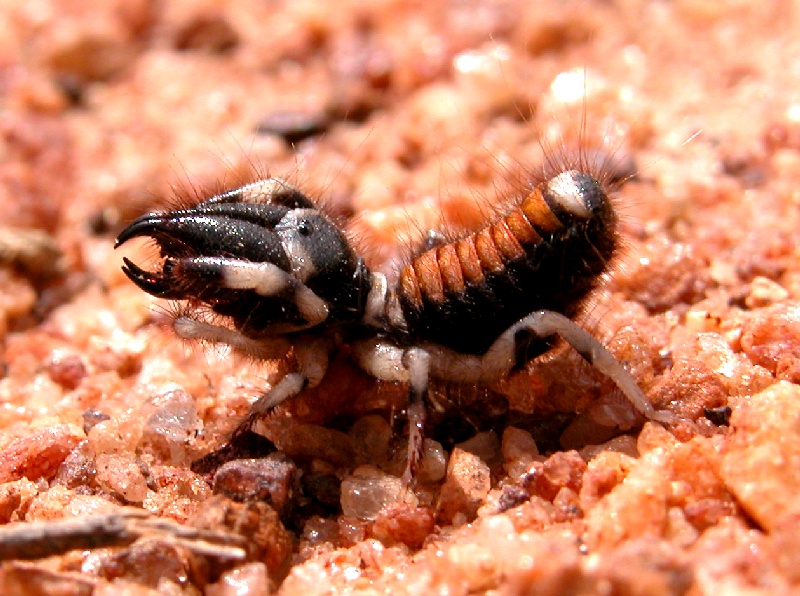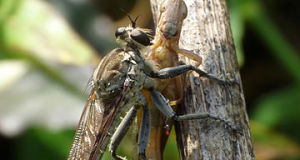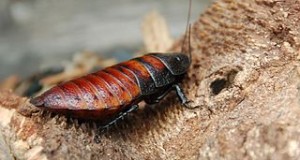
Range and Reputation
The world’s 1,000+ Windscorpion species favor deserts and other warm, arid habitats. They are absent from Australia but otherwise widespread…a number dwell in Florida and the American Southwest. They are among the most active of Arachnids – and their appetites are insatiable.
When out by day, Windscorpions stay to the shadows…their habit of following people, in order to stay shaded, has earned them a quite bad reputation in North Africa. However, while Windscorpions do not actively chase people, their huge, ragged jaws can deliver painful bites, and they should only be handled with tongs.
Keeping Windscorpions
Success in keeping these little-studied invertebrates has been mixed at best. Several species appear regularly in the trade (i.e. Eremobates spp.), but none can be considered easy captives.
 Windscorpions must be kept dry, and they need a great deal of room – more than twice that of similarly-sized scorpions and spiders. A secure, undisturbed environment, stocked with artificial caves and cork bark retreats, is essential A sandy substrate, into which some species will burrow, will also help them to feel at home. Temperature requirements vary by species, but an ambient of 85 F with a warmer area of 92-95 F will suffice for most.
Windscorpions must be kept dry, and they need a great deal of room – more than twice that of similarly-sized scorpions and spiders. A secure, undisturbed environment, stocked with artificial caves and cork bark retreats, is essential A sandy substrate, into which some species will burrow, will also help them to feel at home. Temperature requirements vary by species, but an ambient of 85 F with a warmer area of 92-95 F will suffice for most.
Fast Metabolisms
Windscorpion appetites are huge – no once per week feeding for these beasts! Instead, experiment with every-other-day or even daily feedings, providing all they will take. As we know little of their nutritional requirements, vary the diet as much as possible…crickets, roaches, sow bugs, waxworms and wild-caught moths, grasshoppers and other invertebrates will all be eagerly accepted.
You can also try tong-feeding them canned invertebrates (one look at their other-worldly jaws will convince you of the wisdom of using feeding tongs)!
Folks working with Windscorpions have a real opportunity to contribute to what little we know about these most unusual creatures.
Further Reading
Tailless Whipscorpions are equally odd relatives of the Windscorpions, and easier to keep in captivity. To learn more, please see Tailless Whipscorpions – the Weirdest Invertebrates?
You can check out the imposing jaws of a Windscorpion in this video.
Wind Scorpion image referenced from wikipedia and originally posted by Vijaybarve
 That Reptile Blog – Reptile, Amphibian and Exotic Pet Care and Information
That Reptile Blog – Reptile, Amphibian and Exotic Pet Care and Information



Hello Frank,
Great to highlight these neat creatures!
I have kept a few that I collected several times, as you mentioned they seem to do poorly in captivity overall. I think we are missing something as far as their needs go. One of the longest runs I’ve heard of was on arachnoboards.com of a guy keeping one in a small plastic container hardly big enough for it to turn around, and feeding it sparingly. He got flamed and roasted for it, but the fact remained that the creature lived for over a year and molted successfully! I’ve seen/heard they tend to run themselves to death in captivity if they can’t find a hiding place they like.
I collected 2 Gravid female Eremobates sp. at about 4500 feet elevation in different areas of California.(small…a little bigger than a large female house cricket) Both of them eventually laid eggs for me(I actually have photos of one doing so)…which I promptly seperated because I’ve heard of many eating the eggs. Both females lost appetite and died within 2 weeks of laying, they pretty much shriveled up. However, this was right before I was about to go to college and my folks did not agree with me bringing them along. I ended up sending the eggs to 2 people in hopes of updates. Apparently at least one person succeeded in hatching the eggs, but the babies failed to survive(still waiting on those photos…). They seem to have very exacting humidity requirements(to wet and mold gets em, too dry and they shrivel up like the termites they resemble) and also are prone to escaping(heard of someone hatching them and they all ran away!). What to feed them is also a problem since they are but a few mm in length when they hatch. I’d like to try again now that I am all settled in but need to find some more gravid females first. At least for this species room temperature was fine. Actually, night temps when they were active were down in the 60’s. They like hanging around lights such as camp outhouses, probably to feed on all the manner of bugs drawn their by the lights.
Anyway, enough rambling…and I’d love to hear any experience you’ve had(kept any of the large African sp. by any chance?)
Hope you and your family are having a fun filled holiday season.
~Joseph
Hello Joseph, Frank Indiviglio here.
Well, not many of us writing on Windscorpions this Christmas night, nice to see your interesting notes…I’ll keep them on hand for future reference.
Unfortunately, the few large ones that have passed through my hands (not literally, I’d sooner grab an angry Tasmanian Devil!) were in bad shape, having been confiscated in large shipments of other animals – likely tossed in as “extras” or curiosities, and they did not fare well. Staten Island Zoo was looking into working with them at one point…project on hold right now, but if it picks up I should have more to report in the future.
I’m trying to include them in an African Invertebrate exhibit for an aquarium in CT. also – funding a problem now, but perhaps when the economy picks up….
Take care, a Happy and Healthy New Year to you and yours,
Best regards, Frank Indiviglio.
Hello Frank, and thanks for the note. Here’s to 2010!
Indeed, not many people writing about them at all. I do read of one arachnologist, Punzo, who reared Eremobates sp. through its whole lifecycle and describes how he did it in his($300…don’t take “Solifugid biology 101”!) book. I don’t think anyone has had much success with the big guys other than keeping than alive for about a year at most.
I wonder if the hyperactive killer racing across the sand that we see is really only a small part of the picture and the lifecycle. Perhaps the majority of life is spent deep in cool underground burrows and only rarely do they come up to the surface and go into 4th gear for feeding/mating purposes.
Good luck with including these in the exhibit! If you can find a good way to put them on display i bet they would cause quite a stir. I’ve got way to many “My son/bro/cousin/best HS bud went to Iraq and their are these huge camel spiders that run at 40mph, scream while chasing you, disembowel camels by leaping 5 feet into the air and biting them in the belly, chew your feet off while you are sleeping and benumb you with venom, etc. etc. Good stuff!
Hello Joseph, Frank Indiviglio here.
Great point concerning their life cycle; for decades (and still) zoos exhibited Gils Monsters in “desert exhibits” – hot and bone dry. Many wondered why the lizards invariably spent as much time as possible soaking in their water bowls. Turns out that in the wild they are below ground for about 90% of their lives, at humidity levels of 60-70%! They come out only to mate and for rare feeding forays….some may take only 2-3 large meals per year. Friends working with radio-tagged Pine Snakes in NJ have found a similar pattern – they spend most of their time at different humidity and temperature levels than one would expect, given their range.
Good luck and please keep me posted.
Best regards, Frank Indiviglio.
Oh, also, can I ask…how much funding does a public institution usually set aside on any one display?(I know this can vary wildy from “roach petting zoo/life in a rotting log” to “undersea shark encounter/rainforest trek”)but an average/lowball figure would be nice!
~Joseph
Hello Joseph, Frank Indiviglio here.
Sorry, as you suspect no average possible. Much depends on the institution – private or public, where located, local support, grant-writing success. Bronx Zoo, for example, has access to donors who provide millions in support yearly – names like Roosevelt (a founder), Astor, Vanderbilt etc. still associated with zoo. Usually such donors are above economic downturns, but this year the zoo had to close buildings, fire staff. Government support also critical – i.e. BZ gets land rent free, water, etc. in return for providing free admission to visitors on 1 date each week, and so on.
New exhibit funding is often via a specific donor or group – i.e. Jungleworld, opened in 1985 at a cost of appx. 30 million, was largely funded by 1 person, who also established a fund for maintenance.
Good luck and please keep me posted.
Best regards, Frank Indiviglio.